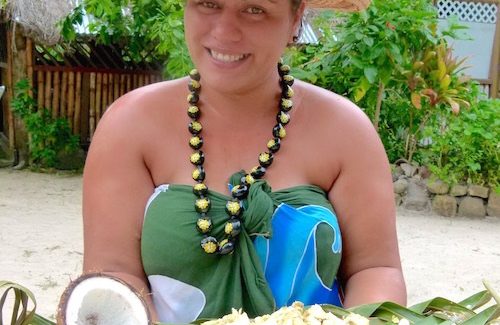Shore Excursion: Island of Moorea said to be inspiration for Bali Hai
By Jackie Sheckler Finch
To discover the Polynesian paradise of Moorea, I rode around the whole island. Of course, that isn’t very difficult. Moorea has only one major road and it takes about one and a half hours to drive the whole thing.
But, oh, what beauty that drive revealed.
The heart-shaped island is said to have inspired the mythical Bali Hai in James Michener’s “Tales of the South Pacific.” Located only 10 nautical miles from Tahiti, Moorea is spectacular in real life, earning the nickname “The Magical Island.”
Like all Polynesian islands, Moorea is rich in mythology. Legend says that a golden skinned lizard abandoned by its human parents became stranded on a reef as it swam after them. Merciful gods turned the baby lizard into the island of Moorea – which means “golden lizard.”
Eight jagged mountain peaks rise from its gorgeous lagoon. Lush greenery is fringed by an azure blue sea and ivory beaches. Waterfalls tumble down fern-covered cliffs. Pastel painted houses are framed by multi-colored arrays of orchids, gardenias, hibiscus and birds of paradise.
I saw fresh-caught fish displayed on a roadside pole for sale. Fruit stands offered just-picked coconuts and pineapples, the main fruit grown on the island. Feral chickens and roosters freely roam everywhere.
“You can’t really eat the chickens. They are too tough,” tour guide Teiva said. “The roosters aren’t fun if you live here. They don’t just crow in the morning. They crow all day long.”
Many front yards feature what looks like a small house or a roof held up by four posts to protect what is under it. The structures resemble a picnic spot decorated with potted plants and bouquets of artificial flowers.
“Those are graves,” Teiva said. “You can bury a body in your yard as long as you get a permit.
The government does that so that the family won’t sell the land. If a family member you love is buried in your front yard, most families would want the land to remain in the family for generations to come.”
Moorea has a population of about 18,000, most of whom live near the coast in the island’s eight small villages. “When we stop at the marae, you will see why most of them don’t live inland,” Teiva said.
In fact, Teiva gave his talk about the historic marae from inside the bus, then he opened the bus door and told us we were on our own. The bus driver also stayed in his seat.
Mosquitoes galore. This part of paradise is mosquito heaven. The inland marae is well shaded and covered with old trees, moss and ferns. Even when we climbed back on board the bus, mosquitoes followed us and were swatted vigorously by Teiva and the driver.
I took photos of the marae but there is little to see. In ancient Polynesia, the open-air sanctuaries were large sacred temples where important events took place. Maraes were for worshipping gods, signing peace treaties, celebrating good harvests and performing rituals asking for victory in wars.
This Moorea marae looked like a big yard encircled by a low wall of small piled rocks, now mostly crumbling. Before the arrival of Europeans in the 18th century, the marae were the centers for social, political and religious activity. The ancient Polynesians were polytheists, which means they believed in more than one god.
When missionaries arrived on Moorea in the 19th century, the maraes were considered pagan and destroyed or abandoned as Polynesians converted to Christianity. If I hadn’t seen the sign and heard the talk by Teiva, I might not have known the importance of the site we were visiting.
Photo by Jackie Sheckler Finch















View Recent Comments